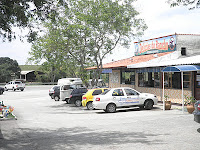 In a frenzy of preparation for the guests we were convinced would be lining up at the front door, our first purchases were bed frames, mattresses, pillows and sheets. I then thought it essential to buy a large calendar to better organize our visitor schedule. We discussed endlessly who we thought would come first, how long people would stay, how many we could accommodate at one time. Would we mix families? Mix family with friends? Could we handle kids? How many? I kept a list of things we would ask people to bring, like the most recent Sunday Times, or my special Crabtree & Evelyn hypo-allergenic face cream. A good friend of ours once told us about a sign she saw hanging in a house in East Hampton, which you see here. I toyed with the idea of hanging this sign in our guest rooms. That's how much in demand I thought we'd be.
In a frenzy of preparation for the guests we were convinced would be lining up at the front door, our first purchases were bed frames, mattresses, pillows and sheets. I then thought it essential to buy a large calendar to better organize our visitor schedule. We discussed endlessly who we thought would come first, how long people would stay, how many we could accommodate at one time. Would we mix families? Mix family with friends? Could we handle kids? How many? I kept a list of things we would ask people to bring, like the most recent Sunday Times, or my special Crabtree & Evelyn hypo-allergenic face cream. A good friend of ours once told us about a sign she saw hanging in a house in East Hampton, which you see here. I toyed with the idea of hanging this sign in our guest rooms. That's how much in demand I thought we'd be.We are grateful to our stalwart family and friends who have come to visit from the U.S., some more than once. We've also had a strong showing of friends from Brazil and Argentina. But let's face it, I threw out my reservation calendar years ago. We now read The Times online, and I found a substitute face cream. The thing is, we still haven't welcomed as many guests as we expected to, or all of the ones we most expected, nor have any guests overlapped. We still have all the extra sheets and towels, which we occasionally have to wash and iron and air out to keep them fresh and clean. (Otherwise, the sea air wreaks moldy havoc.) The mattresses are still nice and new and firm. No matter what, we always keep two guest rooms at the ready. The other rooms? We turned one of them into my painting studio and the last one into a storage space.
 |
| Royal suite |
 |
| Presidential suite |
Do we take the less-than-steady stream of visitors personally? No, we're grownups. We do understand the cost and the bureaucratic annoyance of getting a visa to come to Brazil. We understand how far we are from North America and from Europe. We understand what a pain it is now to travel by plane, with the security concerns, the invasive searches, the discomfort and the constant delays, not to mention ever-rising ticket prices. Yes, we even understand that Brazil — and we — are not on the top of everyone's must-see-before-I-die list.
Again, to those of you who have made the trek — and you know who you are — we thank you! We had a blast, and hope you did, too. For those of you who haven't made it here yet — and you know who you are — our invitation still stands. But you'd better hurry. We just might decide to downsize!





































